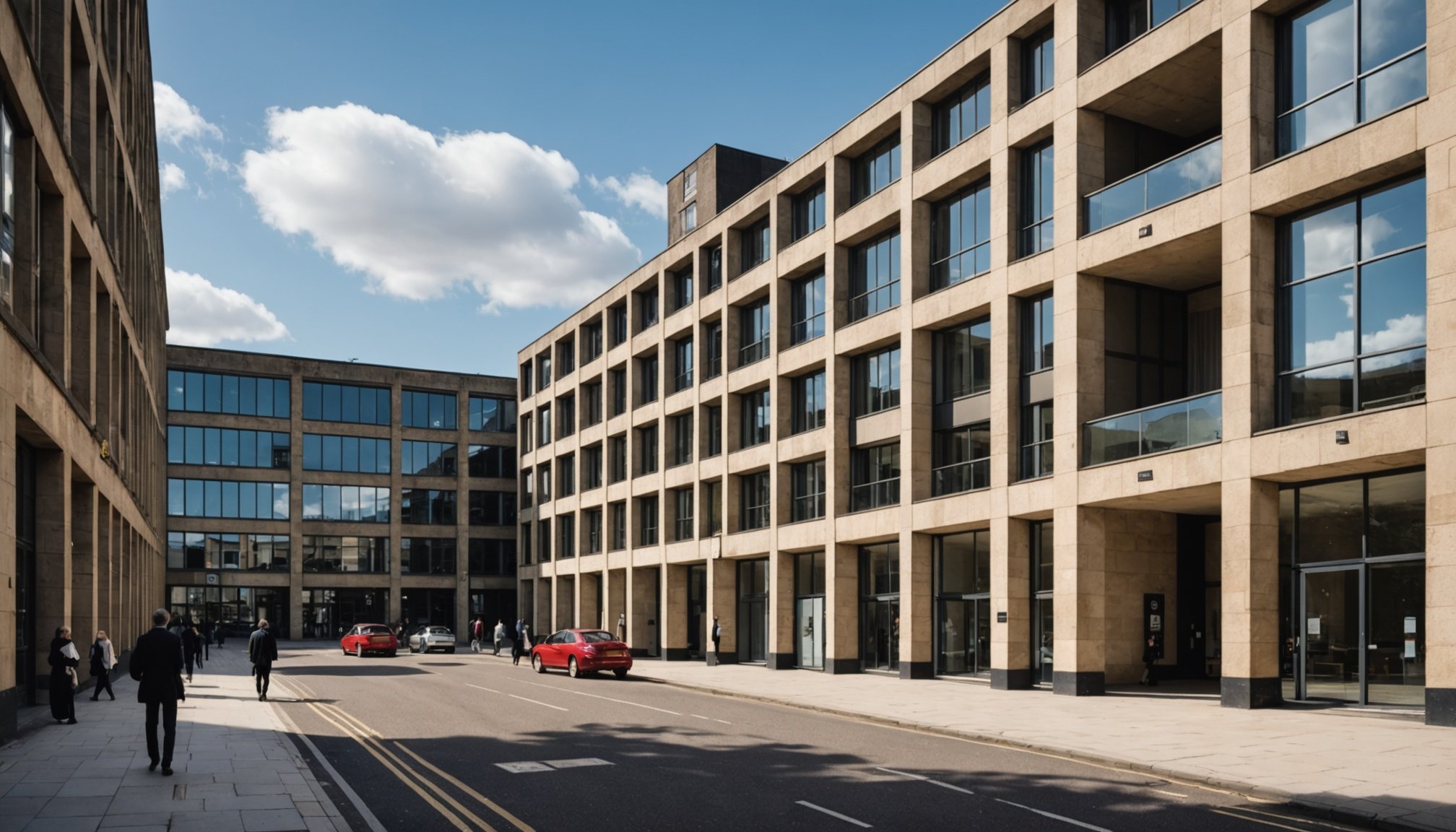Unveiling the Best UK Locations to Experience the Rich Heritage of Post-War British Architecture to Post-War British Architecture
The post-World War II era in Britain was a time of significant transformation, particularly in the realm of architecture. As the country rebuilt and expanded, new towns, housing estates, and public buildings emerged, reflecting a mix of innovative design, social ideology, and practical necessity. This article will guide you through some of the most notable locations in the UK where you can experience the rich heritage of post-war British architecture.
New Towns: A Vision for the Future
One of the most ambitious projects of the post-war period was the creation of new towns. These were designed to alleviate housing shortages and provide modern, planned communities.
First Wave of New Towns
The first wave of new towns was initiated under the New Towns Act 1946. Some of the notable new towns from this period include:
- Stevenage, Hertfordshire: Designated on November 11, 1946, Stevenage was one of the first new towns and set the precedent for others[1].
- Crawley, Sussex: Designated on January 9, 1947, Crawley is another early example, known for its well-planned layout and community facilities[1].
- Harlow, Essex: Designated on March 25, 1947, Harlow is famous for its pedestrian precincts and modernist architecture[1].
These new towns were built with the intention of providing a better quality of life, with amenities such as parks, shopping centers, and community facilities.
Also read : Discovering britain”s nautical heritage: must-visit uk locations for unforgettable guided historical tours
Second and Third Waves
The second wave (1961-1964) and third wave (1967-1970) of new towns continued this trend, with locations like Skelmersdale, Lancashire, and Milton Keynes, Buckinghamshire. Milton Keynes, in particular, was envisioned as a “new city” with a target population of 250,000 and was designed to be a self-sufficient community[1].
Iconic Housing Estates
Post-war Britain also saw the development of innovative housing estates that were designed to address the housing crisis and promote community living.
Park Hill, Sheffield
Park Hill, built in 1960, is a landmark example of post-war housing. This massive estate, often referred to as the “largest listed building in Europe,” was designed by J.K. Lewis Womersley and featured a unique “streets in the air” concept. Initially popular with residents, it later faced decline due to social and economic changes[3].
Robin Hood Gardens, London
Designed by the Smithsons, Robin Hood Gardens is another notable example. Built in the late 1960s, it was intended to maintain community dynamics similar to those of traditional street layouts. However, it lacked key features such as street-level community life and backyards, leading to inherent flaws in its design[3].
Shopping Centers and Public Spaces
Post-war Britain also saw a significant transformation in retail and public spaces, with the development of shopping centers and precincts.
Arndale Shopping Centres
The Arndale Property Trust was instrumental in creating shopping centers across the UK. The first Arndale Centre opened in Shipley in 1960, followed by others in Jarrow, Leeds, and Morecambe. These centers were designed to be modern, covered, and self-contained, reflecting the new era of consumerism and urban planning[4].
Historical Places to Visit
For those interested in exploring the heritage of post-war British architecture, here are some must-visit locations:
Key Locations:
- Park Hill, Sheffield: A pioneering example of “streets in the air” design.
- Robin Hood Gardens, London: A serpentine high-density block that aimed to preserve community dynamics.
- Milton Keynes, Buckinghamshire: A new city designed to be self-sufficient with modernist architecture.
- Arndale Shopping Centre, Leeds: One of the first covered shopping centers in Britain.
- Stevenage, Hertfordshire: One of the first new towns, showcasing planned community living.
Walking Tour Tips:
- Start in London: Visit Robin Hood Gardens and other post-war housing estates to understand the urban planning of the time.
- Head to Sheffield: Explore Park Hill and its unique architecture.
- Visit Milton Keynes: See the vision of a “new city” in action.
- Stop by Leeds: Walk through the Arndale Shopping Centre to experience the early days of modern retail.
Practical Insights and Actionable Advice
When visiting these locations, here are some practical tips to enhance your experience:
Before You Go:
- Research: Read about the history and design principles behind each location to appreciate their significance.
- Guided Tours: Many of these sites offer guided tours that can provide deeper insights into their architecture and historical context.
During Your Visit:
- Take Your Time: Walk around the estates and shopping centers to observe the details of the architecture.
- Talk to Locals: Engage with residents or shopkeepers to get a firsthand account of living or working in these post-war developments.
After Your Visit:
- Reflect: Consider how these architectural innovations have influenced modern urban planning and housing design.
- Share Your Experience: Write about or share photos of your visit to help others appreciate these historical places.
Table: Comparative Overview of Notable Post-War Developments
| Location | Designation Year | Architect/Designer | Key Features |
|---|---|---|---|
| Stevenage | 1946 | Gordon Stephenson | Planned community, pedestrian precincts |
| Park Hill, Sheffield | 1960 | J.K. Lewis Womersley | “Streets in the air” concept, maisonettes with internal staircases |
| Robin Hood Gardens | Late 1960s | The Smithsons | Serpentine high-density block, community dynamics preservation |
| Milton Keynes | 1967 | Derek Walker | New city design, self-sufficient community, modernist architecture |
| Arndale Shopping Centre, Leeds | 1967 | John Poulson | First covered shopping center in Britain, modern retail design |
Quotes from Architects and Critics
- On Park Hill: “It proved popular with its residents, who loved their flats and soon formed an effective association. It was also much lauded in architectural circles… Its size and hillside location made it the prime example of ‘streets in the air’ nationally, and for a decade or so it thronged with international visitors.”[3]
- On Robin Hood Gardens: “What the Smithsons wanted to achieve was intended to maintain community dynamics rather than to replace them with something entirely different. However, what they had not expected… was that three principal features of the by-law street would be absent in their proposed blocks.”[3]
- On Arndale Centres: “The Arndale Shopping Centre in Jarrow… opened in 1961. The open-air Bede and Viking Precincts met at right angles to form a new town centre. Chippindale’s gift of a statue of two chunky Vikings, carved by Colin M. Davidson, proved controversial, but remains in place.”[4]
Post-war British architecture is a testament to the country’s resilience and innovative spirit. From the new towns designed to alleviate housing shortages to the pioneering housing estates and modern shopping centers, these locations offer a unique glimpse into Britain’s recent history. Whether you are an architecture enthusiast, a history buff, or simply someone curious about the evolution of urban planning, these sites are must-visit destinations that provide a rich and engaging experience.
By exploring these historical places, you not only appreciate the architectural heritage but also gain insights into the social, economic, and cultural context of post-war Britain. So, embark on this journey to uncover the best of UK’s post-war architecture and discover how these innovations continue to shape the country’s urban landscape today.











